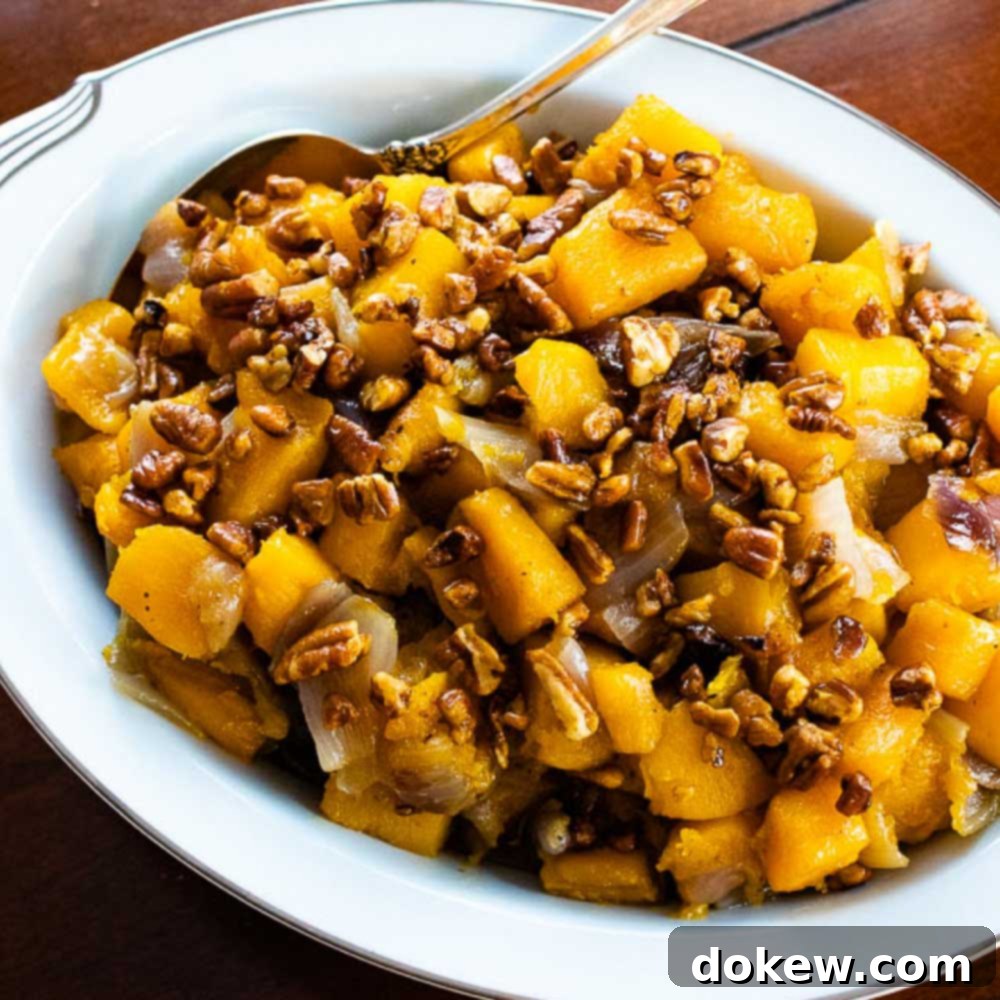Sweet & Savory Roasted Butternut Squash with Candied Pecans: The Ultimate Fall Side Dish
As autumn leaves begin to change and a crispness fills the air, our culinary cravings often turn to comforting, seasonal flavors. There’s no better way to celebrate the bounty of fall than with a dish that perfectly balances sweetness and savory notes, highlighted by the warm embrace of nutmeg. This roasted butternut squash with candied pecans recipe is precisely that – a quintessential fall side dish that’s as delightful to look at as it is to eat. Its vibrant, rich orange hue, combined with the caramelized crunch of candied pecans and the subtle spice of nutmeg, makes it an absolutely superb choice for any autumn gathering, especially as a star accompaniment to your Thanksgiving feast.
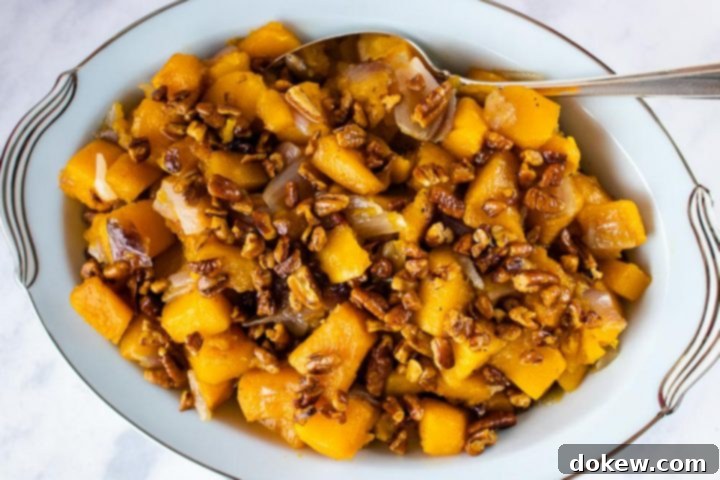
The Nutritional Powerhouse: Understanding Butternut Squash
Often perceived as a vegetable, butternut squash is technically a fruit, much like all other squash varieties. Beyond its delicious taste and beautiful color, it’s a nutritional powerhouse, making it a healthy addition to any meal. This incredible squash is packed with vital nutrients, including an abundance of carotenoids – notably beta-carotene, which is converted to Vitamin A in the body and plays a crucial role in vision, immune function, and skin health. It’s also a great source of other essential vitamins such as B and E. Furthermore, butternut squash provides both soluble and insoluble fiber, aiding in digestive health and helping to regulate blood sugar levels. Incorporating this versatile fruit into your diet means enjoying both exquisite flavor and significant health benefits.
Choosing the Perfect Butternut Squash
The success of any squash dish begins with selecting the best produce. When you’re at the market, look for butternut squash that exhibits a uniform, creamy beige color without any green patches, which can indicate immaturity. Avoid any squash with noticeable blemishes like deep cracks, cuts, soft spots, or significant discolorations, as these can be signs of spoilage or damage. A good butternut squash should feel heavy for its size, signaling a dense flesh and ample moisture content. Gently tap the squash; a hollow sound often indicates ripeness. These simple selection tips will ensure you start with the highest quality ingredient for your roasted masterpiece.
Preparing Butternut Squash for Roasting
Preparing butternut squash can seem daunting due to its tough skin, but with a few tips, it becomes quite manageable. While some people choose not to wash squash that will be peeled, it’s always a good practice to wash all produce thoroughly with soap and water before preparation. To peel the butternut squash, a sturdy vegetable peeler works best. If you find the skin particularly resistant, try a little trick: carefully cut about an inch off both the top and bottom ends, then microwave the whole squash for approximately two to three minutes. This gentle heating will soften the skin, making it much easier to peel. After peeling, carefully slice the squash in half lengthwise. Use a spoon to scoop out and discard all the seeds and fibrous strings from the hollow cavity. Once cleaned, you’re ready to proceed with cutting the squash into your desired shape for roasting.
How to Make Roasted Butternut Squash with Candied Pecans
Crafting this delicious side dish is simpler than you might think. Follow these steps to achieve perfectly tender, caramelized squash and crunchy, sweet pecans.
Cutting the Butternut Squash
Once peeled and deseeded, place the squash on a cutting board. For easier handling, first separate the bulbous body from the cylindrical neck. Slice each section into long, even planks, then cut these planks into strips, and finally turn the strips to dice them into approximately 1-inch cubes. Uniform cubes are key for even roasting, ensuring every piece cooks to the same tender consistency. Transfer all the cubed squash into a large mixing bowl.
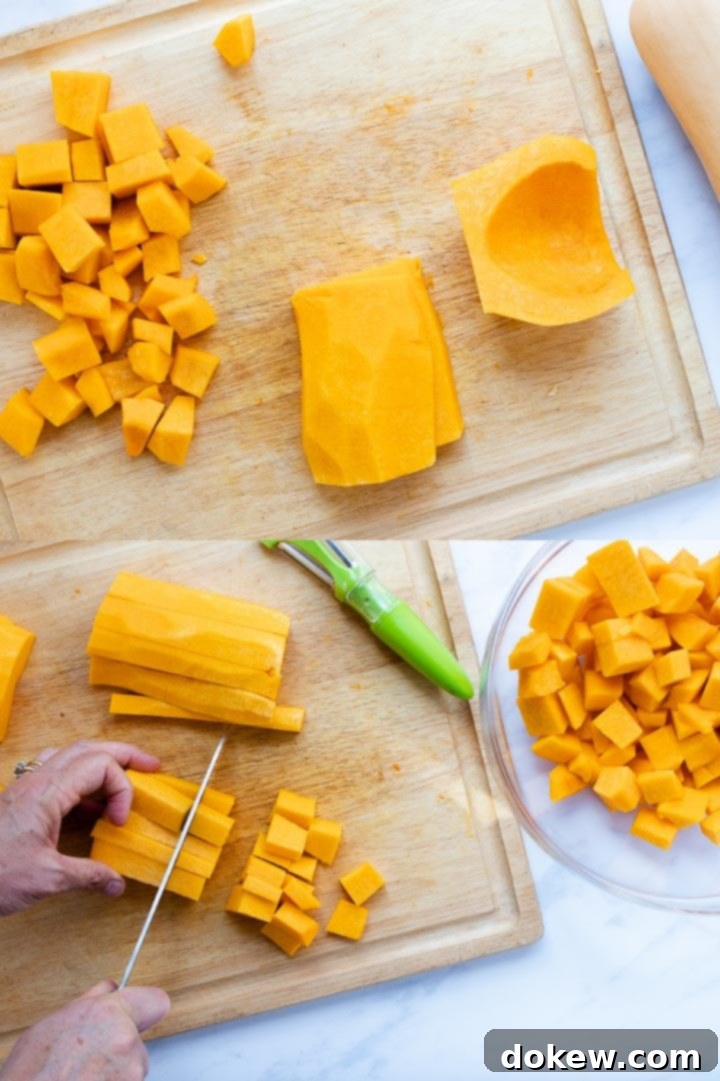
Seasoning and Roasting the Vegetables
Finely chop your red onions into similar 1-inch pieces and add them to the bowl with the cubed squash. Drizzle the oil over the vegetables and toss thoroughly to ensure every piece is lightly coated. This helps with even browning and seasoning. Prepare a large sheet pan with sides or a roasting pan by lightly coating it with non-stick cooking spray or lining it with parchment paper for easier cleanup. It’s crucial to use a pan with sides, as butternut squash releases a significant amount of liquid during the roasting process. Spread the oiled squash and onions evenly in a single layer on the prepared pan. This single layer is vital for roasting, allowing the vegetables to caramelize rather than steam.
Now for the sweet and spicy elements: evenly sprinkle the brown sugar over the distributed vegetables. Next, add the nutmeg. Nutmeg is potent, so a little goes a long way. Start with about ¼ teaspoon of freshly ground nutmeg or adjust to your personal preference. Freshly ground nutmeg offers a superior aroma and flavor compared to pre-ground versions, delivering a more intense and fragrant spice. While a special grinder is great, a simple microplane grater works beautifully with whole nutmeg.
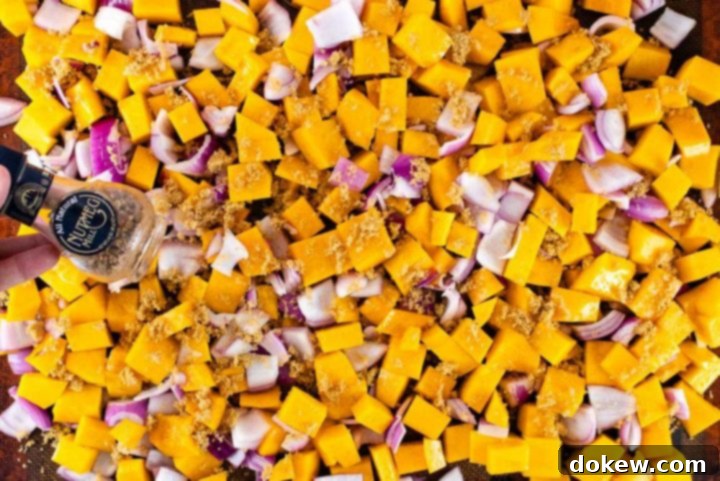
For the best distribution of the seasonings, I find it easiest and most effective to mix everything by hand. Gently get in there with your clean hands and toss the vegetables until the brown sugar and nutmeg are evenly coated. Be gentle to avoid mashing the squash. Place the pan into a preheated oven at 450ºF (230ºC) and bake for approximately 35-45 minutes. Stir the vegetables once or twice during baking to ensure even cooking and browning. The squash is ready when its edges begin to turn a beautiful golden brown and all the liquid released during roasting has evaporated, leaving behind caramelized goodness.
Making the Candied Pecans
While your butternut squash is roasting to perfection, it’s the ideal time to prepare the candied pecans. In a small non-stick frying pan, melt the butter over medium heat. Once melted, add the pecan pieces and toss them to ensure they are fully coated in the butter. Next, sprinkle in the brown sugar. Continue to cook, stirring frequently, for about 8-10 minutes. Keep a close eye on them; you’re looking for the pecans to start browning and the sugar to caramelize into a glistening, syrupy coating. As soon as they reach this stage, remove the pan from the heat and transfer the pecans onto a piece of parchment paper or a plate to cool completely. As they cool, they will harden and become deliciously crunchy. Be cautious, as caramelized sugar is very hot.
Final Assembly and Serving
Once the roasted squash is out of the oven and slightly cooled, it’s time to incorporate the candied pecans. Gently mix about one-half to two-thirds of the cooled candied pecans into the roasted squash. The exact amount can depend on your preference and the size of your serving dish – you might want to reserve more for a visual topping. Carefully transfer the mixture into your chosen serving dish. Finally, sprinkle the remaining candied pecans on top for an appealing presentation and an extra textural contrast. Serve this exquisite side dish immediately to enjoy its warmth and fresh flavors.
Recipe: Roasted Butternut Squash with Candied Pecans
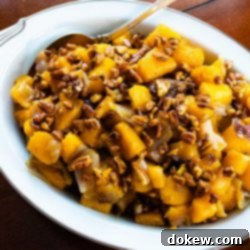
Roasted Butternut Squash with Candied Pecans
This roasted butternut squash recipe, featuring a hint of nutmeg and sweet candied pecans, creates a perfect blend of sweet and savory. Its gorgeous fall color and enticing flavors make it an essential side for Thanksgiving or any seasonal meal.
Author: Mary Ann
Prep Time: 25 mins
Cook Time: 40 mins
Total Time: 1 hr 5 mins
Course: Side Dish
Cuisine: American, Gluten-free, Vegetarian
Servings: 8 servings
Calories: 276
Ingredients
For the Squash:
- ¼ cup oil (e.g., olive oil or avocado oil)
- ⅓ cup brown sugar
- 2 medium butternut squash
- 3 medium red onions
- ¼ teaspoon freshly ground nutmeg (or to taste)
- Non-stick cooking spray (for the pan)
For the Candied Pecans:
- ¾ cup pecan pieces
- 2½ teaspoons butter
- 1½ teaspoons brown sugar
Instructions
- Preheat your oven to 450ºF (230ºC).
- Peel both butternut squash and chop them into uniform 1-inch cubes.
- Chop the 3 red onions into 1-inch pieces, similar in size to the squash.
- In a large bowl, combine the chopped onions and squash with ¼ cup of oil. Toss well to ensure all vegetables are lightly coated.
- Prepare a large roasting pan with sides by coating it with non-stick cooking spray. Spread the squash and onion mixture evenly in a single layer on the pan.
- Evenly sprinkle ⅓ cup of brown sugar over the vegetables. Then, sprinkle ¼ teaspoon of freshly ground nutmeg (or more, to your preference) over the seasoned vegetables.
- Using clean hands, gently mix the vegetables to distribute the brown sugar and nutmeg evenly. Be careful not to mash the squash.
- Bake for 35-45 minutes, stirring gently once or twice during baking to promote even caramelization.
- While the squash is baking, proceed with preparing the candied pecans as described in the next section.
- The squash is done when the edges begin to brown and caramelize, and any liquid in the pan has evaporated. Remove the pan from the oven.
- Gently stir one-half to two-thirds of the cooled candied pecans into the roasted squash. Transfer the mixture into a serving bowl. Sprinkle the remaining pecans on top for garnish and serve immediately.
Candied Pecans Instructions:
- While the vegetables are roasting, melt 2½ teaspoons of butter in a small non-stick frying pan over medium heat.
- Add ¾ cup of pecan pieces to the melted butter and toss to coat thoroughly.
- Next, add 1½ teaspoons of brown sugar to the pan. Cook, stirring frequently, for about 8-10 minutes.
- Continue cooking until the pecans start to brown slightly and the sugar begins to caramelize into a glossy coating.
- Remove from heat immediately and spread the candied pecans on a piece of parchment paper or a plate to cool completely. They will crisp up as they cool.
Notes
- Always use a roasting pan with sides, as the vegetables will release a fair amount of liquid during cooking. This prevents spills and ensures the liquid reduces and caramelizes.
- When stirring the squash during baking or when mixing in the pecans, be very gentle to prevent the tender squash from mashing.
Nutrition per serving
Calories: 276 cal | Carbohydrates: 36 g | Protein: 3 g | Fat: 15 g | Sodium: 16 mg | Fiber: 5 g | Sugar: 15 g | Net Carbohydrates: 31 g
Tips for Success & Creative Variations
Achieving the perfect roasted butternut squash with candied pecans is all about attention to detail. For optimal caramelization, ensure your squash and onions are spread in a single layer on the baking sheet; overcrowding will lead to steaming instead of roasting. Don’t skip stirring during baking, as this helps achieve even browning and prevents sticking. When making the candied pecans, constant stirring on medium heat is key to prevent burning the sugar and ensuring a uniform coating.
Feel free to experiment with this recipe to suit your taste or occasion:
- Spice It Up: Beyond nutmeg, consider adding a pinch of cinnamon, allspice, or even a tiny amount of ground cloves for a more complex fall spice profile. For a touch of heat, a whisper of cayenne pepper can add an unexpected kick.
- Herbaceous Notes: Fresh herbs like rosemary or thyme, added with the oil before roasting, can introduce an aromatic, savory depth that beautifully complements the sweet and nutty elements.
- Different Nuts: While pecans are traditional, walnuts or even almonds could be used for the candied topping, offering slightly different textures and flavors.
- Maple or Honey: Instead of brown sugar for roasting the squash, a drizzle of maple syrup or honey can be used, providing a natural sweetness and slightly different caramelization characteristics. Adjust quantities to your preference.
- Savory Twist: For a less sweet version, reduce the brown sugar on the squash and omit the candied pecans entirely, instead topping with toasted plain pecans or a sprinkle of Parmesan cheese and fresh parsley after roasting.
Storage and Reheating Instructions
This roasted butternut squash with candied pecans is best enjoyed fresh from the oven, but leftovers can be delicious too!
- Storage: Store any leftover roasted squash and pecans in an airtight container in the refrigerator for up to 3-4 days. It’s best to store them mixed together, as the candied pecans will retain some crunch even after cooling.
- Reheating: To reheat, spread the mixture evenly on a baking sheet and warm in an oven preheated to 350ºF (175ºC) for 10-15 minutes, or until heated through. This method helps to crisp up the pecans and caramelize the squash edges again. Alternatively, you can microwave individual portions, though the pecans might lose some of their crunchiness.
Frequently Asked Questions (FAQ)
Here are answers to some common questions about making roasted butternut squash with candied pecans:
Q: Can I prepare butternut squash ahead of time?
A: Yes, you can peel and cube the butternut squash up to 2-3 days in advance. Store the cubed squash in an airtight container in the refrigerator. If you notice any moisture, pat it dry before roasting to ensure good caramelization.
Q: What if I don’t have fresh nutmeg?
A: While freshly ground nutmeg offers the best flavor, you can certainly use pre-ground nutmeg. Adjust the quantity to taste, starting with about half the recommended amount as pre-ground spices can be more potent.
Q: Can I use a different type of squash?
A: Absolutely! While butternut squash is ideal for its sweetness and texture, you could try this recipe with other hard winter squash varieties like acorn squash, delicata squash (which often doesn’t need peeling!), or even kabocha squash. Roasting times might vary slightly depending on the squash type and how densely it’s cut.
Q: My candied pecans stuck together or are too sticky. What went wrong?
A: This often happens if the pecans weren’t spread out quickly enough to cool, or if they were cooked for too long or not long enough. Ensure you spread them in a single layer on parchment paper immediately after removing them from heat. They should crisp up as they cool. If they remain sticky, you can gently break them apart before serving.
Q: Can I make this recipe vegan?
A: Yes, this recipe can easily be made vegan. Simply substitute the butter for a plant-based butter alternative or coconut oil when making the candied pecans. The rest of the ingredients are naturally vegan.
